Punched card

Apunched card(alsopunch card[1]orpunched-card[2]) is a piece ofcard stockthat storesdigital datausing punched holes. Punched cards were once common indata processingand the control ofautomated machines.
Punched cards were widely used in the 20th century, whereunit record machines,organized intodata processing systems,used punched cards for data input, output, and storage.[3][4]TheIBM12-row/80-column punched card format came to dominate the industry. Many earlydigital computersused punched cards as the primary medium for input of bothcomputer programsanddata.
Data can be entered onto a punched card using akeypunch.
While punched cards are now obsolete as astorage medium,as of 2012, somevoting machinesstill used punched cards to record votes.[5]Punched cards also had a significant cultural impact in the 20th century.

History
[edit]The idea of control and data storage via punched holes was developed independently on several occasions in the modern period. In most cases there is no evidence that each of the inventors was aware of the earlier work.
Precursors
[edit]
Basile Bouchondeveloped the control of aloomby punched holes in paper tape in 1725. The design was improved by his assistant Jean-Baptiste Falcon and byJacques Vaucanson.[6]Although these improvements controlled the patterns woven, they still required an assistant to operate the mechanism.
In 1804Joseph Marie Jacquarddemonstrated a mechanism to automate loom operation. A number of punched cards were linked into a chain of any length. Each card held the instructions forshedding(raising and lowering thewarp) and selecting the shuttle for a single pass.[7]
Semyon Korsakovwas reputedly the first to propose punched cards in informatics for information store and search. Korsakov announced his new method and machines in September 1832.[8]
Charles Babbageproposed the use of "Number Cards", "pierced with certain holes and stand[ing] opposite levers connected with a set of figure wheels... advanced they push in those levers opposite to which there are no holes on the cards and thus transfer that number together with its sign" in his description of the Calculating Engine's Store.[9]There is no evidence that he built a practical example.
In 1881Jules Carpentierdeveloped a method of recording and playing back performances on aharmoniumusing punched cards. The system was called theMélographe Répétiteurand "writes down ordinary music played on the keyboard dans le langage de Jacquard",[10]that is as holes punched in a series of cards. By 1887 Carpentier had separated the mechanism into theMelographwhich recorded the player's key presses and theMelotropewhich played the music.[11][12]
20th century
[edit]At the end of the 1800sHerman Hollerithcreated a method for recording data on a medium that could then be read by a machine,[13][14][15][16]developing punched card data processing technology for the1890 U.S. census.[17]Histabulating machinesread and summarized data stored on punched cards and they began use for government and commercial data processing.
Initially, theseelectromechanicalmachines only counted holes, but by the 1920s they had units for carrying out basic arithmetic operations.[18]: 124 Hollerith founded theTabulating Machine Company(1896) which was one of four companies that wereamalgamated via stock acquisitionto form a fifth company,Computing-Tabulating-Recording Company(CTR) in 1911, later renamedInternational Business Machines Corporation (IBM)in 1924. Other companies entering the punched card business includedThe Tabulator Limited(Britain, 1902),Deutsche Hollerith-Maschinen Gesellschaft mbH (Dehomag)(Germany, 1911),Powers Accounting Machine Company(US, 1911),Remington Rand(US, 1927), andH.W. Egli Bull(France, 1931).[19]These companies, and others, manufactured and marketed a variety of punched cards andunit record machinesfor creating, sorting, and tabulating punched cards, even after the development of electronic computers in the 1950s.

Both IBM and Remington Rand tied punched card purchases to machine leases, a violation of the US 1914Clayton Antitrust Act.In 1932, the US government took both to court on this issue. Remington Rand settled quickly. IBM viewed its business as providing a service and that the cards were part of the machine. IBM fought all the way to the Supreme Court and lost in 1936; the court ruled that IBM could only set card specifications.[20][21]: 300–301
"By 1937... IBM had 32 presses at work in Endicott, N.Y., printing, cutting and stacking five to 10 million punched cards every day."[22]Punched cards were even used as legal documents, such asU.S. Governmentchecks[23]and savings bonds.[24]
DuringWorld War IIpunched card equipment was used by the Allies in some of their efforts to decrypt Axis communications. See, for example,Central Bureauin Australia. AtBletchley Parkin England, "some 2 million punched cards a week were being produced, indicating the sheer scale of this part of the operation".[25]In Nazi Germany, punched cards were used for the censuses of various regions and other purposes[26][27](seeIBM and the Holocaust).
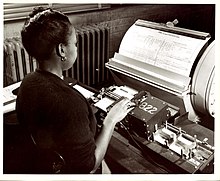
Punched card technology developed into a powerful tool for business data-processing. By 1950 punched cards had become ubiquitous in industry and government. "Do not fold,spindleor mutilate, "a warning that appeared on some punched cards distributed as documents such as checks and utility bills to be returned for processing, became a motto for the post-World War IIera.[28][29]
In 1956[30]IBM signed aconsent decreerequiring, amongst other things, that IBM would by 1962 have no more than one-half of the punched card manufacturing capacity in the United States.Tom Watson Jr.'sdecision to sign this decree, where IBM saw the punched card provisions as the most significant point, completed the transfer of power to him fromThomas Watson, Sr.[21]
The UnivacUNITYPERintroduced magnetic tape for data entry in the 1950s. During the 1960s, the punched card was gradually replaced as the primary means fordata storagebymagnetic tape,as better, more capable computers became available.Mohawk Data Sciencesintroduced a magnetic tape encoder in 1965, a system marketed as a keypunch replacement which was somewhat successful. Punched cards were still commonly used for entering both data and computer programs until the mid-1980s when the combination of lower costmagnetic disk storage,and affordableinteractive terminalson less expensiveminicomputersmade punched cards obsolete for these roles as well.[31]: 151 However, their influence lives on through many standard conventions and file formats. The terminals that replaced the punched cards, theIBM 3270for example, displayed 80columns of textintext mode,for compatibility with existing software. Some programs still operate on the convention of 80 text columns, although fewer and fewer do as newer systems employgraphical user interfaceswith variable-width type fonts.
Nomenclature
[edit]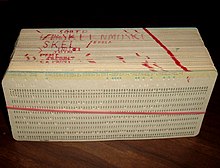
The termspunched card,punch card,andpunchcardwere all commonly used, as wereIBM cardandHollerith card(afterHerman Hollerith).[1]IBM used "IBM card" or, later, "punched card" at first mention in its documentation and thereafter simply "card" or "cards".[33][34]Specific formats were often indicated by the number of character positions available, e.g.80-column card.A sequence of cards that is input to or output from some step in an application's processing is called acard deckor simplydeck.The rectangular, round, or oval bits of paper punched out were calledchad(chads) orchips(in IBM usage). Sequential card columns allocated for a specific use, such as names, addresses, multi-digit numbers, etc., are known as afield.The first card of a group of cards, containing fixed or indicative information for that group, is known as amaster card.Cards that are not master cards aredetail cards.
Formats
[edit]The Hollerith punched cards used for the 1890 U.S. census were blank.[35]Following that, cards commonly had printing such that the row and column position of a hole could be easily seen. Printing could include having fields named and marked by vertical lines, logos, and more.[36]"General purpose" layouts (see, for example, the IBM 5081 below) were also available. For applications requiring master cards to be separated from following detail cards, the respective cards had different upper corner diagonal cuts and thus could be separated by a sorter.[37]Other cards typically had one upper corner diagonal cut so that cards not oriented correctly, or cards with different corner cuts, could be identified.
Hollerith's early cards
[edit]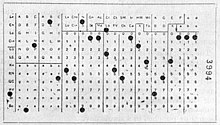
Herman Hollerithwas awarded three patents[39]in 1889 for electromechanicaltabulating machines.These patents described bothpaper tapeand rectangular cards as possible recording media. The card shown inU.S. patent 395,781of January 8 was printed with a template and had hole positions arranged close to the edges so they could be reached by arailroad conductor'sticket punch,with the center reserved for written descriptions. Hollerith was originally inspired by railroad tickets that let the conductor encode a rough description of the passenger:
I was traveling in the West and I had a ticket with what I think was called a punch photograph...the conductor...punched out a description of the individual, as light hair, dark eyes, large nose, etc. So you see, I only made a punch photograph of each person.[18]: 15
When use of the ticket punch proved tiring and error-prone, Hollerith developed thepantograph"keyboard punch". It featured an enlarged diagram of the card, indicating the positions of the holes to be punched. A printed reading board could be placed under a card that was to be read manually.[35]: 43
Hollerith envisioned a number of card sizes. In an article he wrote describing his proposed system for tabulating the1890 U.S. census,Hollerith suggested a card3 by5+1⁄2inches (7.6 by 14.0 cm) ofManila stock"would be sufficient to answer all ordinary purposes."[40]The cards used in the 1890 census had round holes, 12 rows and 24 columns. A reading board for these cards can be seen at the Columbia University Computing History site.[41]At some point,3+1⁄4by7+3⁄8inches (83 by 187 mm) became the standard card size. These are the dimensions of thethen-current paper currencyof 1862–1923.[42]This size was needed in order to use available banking-type storage for the 60,000,000 punched cards to come nationwide.[41]
Hollerith's original system used an ad hoc coding system for each application, with groups of holes assigned specific meanings, e.g. sex or marital status. His tabulating machine had up to 40 counters, each with a dial divided into 100 divisions, with two indicator hands; one which stepped one unit with each counting pulse, the other which advanced one unit every time the other dial made a complete revolution. This arrangement allowed a count up to 9,999. During a given tabulating run counters were assigned specific holes or, usingrelay logic,combination of holes.[40]
Later designs led to a card with ten rows, each row assigned a digit value, 0 through 9, and 45 columns.[43] This card provided for fields to record multi-digit numbers that tabulators could sum, instead of their simply counting cards. Hollerith's 45 column punched cards are illustrated inComrie'sThe application of the Hollerith Tabulating Machine to Brown's Tables of the Moon.[44]
IBM 80-column format and character codes
[edit]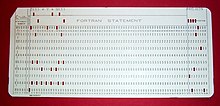
By the late 1920s, customers wanted to store more data on each punched card.Thomas J. Watson Sr.,IBM's head, asked two of his top inventors,Clair D. LakeandJ. Royden Pierce,to independently develop ways to increase data capacity without increasing the size of the punched card. Pierce wanted to keep round holes and 45 columns but to allow each column to store more data, Lake suggested rectangular holes, which could be spaced more tightly, allowing 80 columns per punched card, thereby nearly doubling the capacity of the older format.[45]Watson picked the latter solution, introduced asThe IBM Card,in part because it was compatible with existing tabulator designs and in part because it could be protected by patents and give the company a distinctive advantage.[46]
This IBM card format, introduced in 1928,[47]has rectangular holes, 80 columns, and 10 rows.[48]Card size is7+3⁄8by3+1⁄4inches (187 by 83 mm). The cards are made of smooth stock, 0.007 inches (180 μm) thick. There are about 143 cards to the inch (56/cm). In 1964, IBM changed from square to round corners.[49]They come typically in boxes of 2,000 cards[50]or ascontinuous formcards. Continuous form cards could be both pre-numbered and pre-punched for document control (checks, for example).[51]
Initially designed to record responses toyes–no questions,support for numeric,alphabetic and special characterswas added through the use of columns and zones. The top three positions of a column are calledzone punching positions,12 (top), 11, and 0 (0 may be either a zone punch or a digit punch).[52]For decimal data the lower ten positions are calleddigit punching positions,0 (top) through 9.[52]An arithmetic sign can be specified for a decimal field byoverpunchingthe field's rightmost column with a zone punch: 12 for plus, 11 for minus (CR). ForPound sterlingpre-decimalization currencyapennycolumn represents the values zero through eleven; 10 (top), 11, then 0 through 9 as above. An arithmetic sign can be punched in the adjacentshillingcolumn.[53]: 9 Zone punches had other uses in processing, such as indicating a master card.[54]

Diagram:[55]Note: The 11 and 12 zones were also called the X and Y zones, respectively.
_______________________________________________ / &-0123456789ABCDEFGHIJKLMNOPQR/STUVWXYZ 12| x xxxxxxxxx 11| x xxxxxxxxx 0| x xxxxxxxxx 1| x x x x 2| x x x x 3| x x x x 4| x x x x 5| x x x x 6| x x x x 7| x x x x 8| x x x x 9| x x x x |________________________________________________
In 1931, IBM began introducing upper-case letters and special characters (Powers-Samas had developed the first commercial alphabetic punched card representation in 1921).[56][57][nb 1]The 26 letters have two punches (zone [12,11,0] + digit [1–9]). The languages of Germany, Sweden, Denmark, Norway, Spain, Portugal and Finland require up to three additional letters; their punching is not shown here.[58]: 88–90 Most special characters have two or three punches (zone [12,11,0, or none] + digit [2–7] + 8); a few special characters were exceptions: "&" is 12 only, "-" is 11 only, and "/" is 0 + 1). The Space character has no punches.[58]: 38 The information represented in a column by a combination of zones [12, 11, 0] and digits [0–9] is dependent on the use of that column. For example, the combination "12-1" is the letter "A" in an alphabetic column, a plus signed digit "1" in a signed numeric column, or an unsigned digit "1" in a column where the "12" has some other use. The introduction ofEBCDICin 1964 defined columns with as many as six punches (zones [12,11,0,8,9] + digit [1–7]). IBM and other manufacturers used many different 80-column cardcharacter encodings.[59][60]A 1969 American National Standard defined the punches for 128 characters and was named theHollerith Punched Card Code(often referred to simply asHollerith Card Code), honoring Hollerith.[58]: 7

For some computer applications,binaryformats were used, where each hole represented a single binary digit (or "bit"), every column (or row) is treated as a simplebit field,and every combination of holes is permitted.
For example, on theIBM 701[61]andIBM 704,[62]card data was read, using anIBM 711,into memory in row binary format. For each of the twelve rows of the card, 72 of the 80 columns would be read into two36-bitwords; a control panel was used to select the 72 columns to be read. Software would translate this data into the desired form. One convention was to use columns 1 through 72 for data, and columns 73 through 80 to sequentially number the cards, as shown in the picture above of a punched card for FORTRAN. Such numbered cards could be sorted by machine so that if a deck was dropped the sorting machine could be used to arrange it back in order. This convention continued to be used in FORTRAN, even in later systems where the data in all 80 columns could be read.
As an aid to humans who had to deal with the punched cards, the IBM 026 and later 029 and 129 key punch machines could print human-readable text above each of the 80 columns.
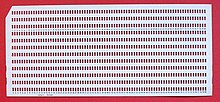
As a prank, punched cards could be made where every possible punch position had a hole. Such "lace cards"lacked structural strength, and would frequently buckle and jam inside the machine.[63]
The IBM 80-column punched card format dominated the industry, becoming known as justIBM cards,even though other companies made cards and equipment to process them.[64]

One of the most common punched card formats is the IBM 5081 card format, a general purpose layout with no field divisions. This format has digits printed on it corresponding to the punch positions of the digits in each of the 80 columns. Other punched card vendors manufactured cards with this same layout and number.
IBMStub cardandShort cardformats
[edit]Long cards were available with a scored stub on either end which, when torn off, left an 80 column card. The torn off card is called astub card.
80-column cards were available scored, on either end, creating both ashort cardand astub cardwhen torn apart. Short cards can be processed by other IBM machines.[51][65]A common length for stub cards was 51 columns. Stub cards were used in applications requiring tags, labels, or carbon copies.[51]
IBM 40-column Port-A-Punch card format
[edit]According to the IBM Archive:IBM's Supplies Division introduced the Port-A-Punch in 1958 as a fast, accurate means of manually punching holes in specially scored IBM punched cards. Designed to fit in the pocket, Port-A-Punch made it possible to create punched card documents anywhere. The product was intended for "on-the-spot" recording operations—such as physical inventories, job tickets and statistical surveys—because it eliminated the need for preliminary writing or typing of source documents.[66]
-
IBM Port-A-Punch
-
FORTRAN Port-A-Punch card. Compiler directive "SQUEEZE" removed the alternating blank columns from the input.
-
Port-a-punch
IBM 96-column format
[edit]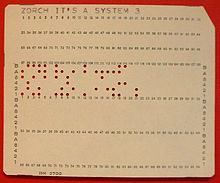
In 1969 IBM introduced a new, smaller, round-hole, 96-column card format along with theIBM System/3low-end business computer. These cards have tiny, 1 mm diameter circular holes, smaller than those inpaper tape.Data are stored in 6-bitBCD,with three rows of 32 characters each, or 8-bitEBCDIC.In this format, each column of the top tiers are combined with two punch rows from the bottom tier to form an 8-bit byte, and the middle tier is combined with two more punch rows, so that each card contains 64 bytes of 8-bit-per-byte binary coded data.[67]As in the 80 column card, readable text was printed in the top section of the card. There was also a 4th row of 32 characters that could be printed. This format was never widely used; it was IBM-only, but they did not support it on any equipment beyond the System/3, where it was quickly superseded by the 1973IBM 3740 Data Entry Systemusing8-inch floppy disks.
Powers/Remington Rand/UNIVAC 90-column format
[edit]

The Powers/Remington Rand card format was initially the same as Hollerith's; 45 columns and round holes. In 1930,Remington Randleap-frogged IBM's 80 column format from 1928 by coding two characters in each of the 45 columns – producing what is now commonly called the 90-column card.[31]: 142 There are two sets of six rows across each card. The rows in each set are labeled 0, 1/2, 3/4, 5/6, 7/8 and 9. The even numbers in a pair are formed by combining that punch with a 9 punch. Alphabetic and special characters use 3 or more punches.[68][69]
Powers-Samas formats
[edit]The BritishPowers-Samascompany used a variety of card formats for theirunit record equipment.They began with 45 columns and round holes. Later 36, 40 and 65 column cards were provided. A 130 column card was also available – formed by dividing the card into two rows, each row with 65 columns and each character space with 5 punch positions. A 21 column card was comparable to the IBM Stub card.[53]: 47–51
Mark sense format
[edit]
Mark sense(electrographic) cards, developed byReynold B. Johnsonat IBM,[70]have printed ovals that could be marked with a special electrographic pencil. Cards would typically be punched with some initial information, such as the name and location of an inventory item. Information to be added, such as quantity of the item on hand, would be marked in the ovals. Card punches with an option to detect mark sense cards could then punch the corresponding information into the card.
Aperture format
[edit]
Aperture cardshave a cut-out hole on the right side of the punched card. A piece of 35 mm microfilm containing amicroformimage is mounted in the hole. Aperture cards are used forengineering drawingsfrom all engineering disciplines. Information about the drawing, for example the drawing number, is typically punched and printed on the remainder of the card.
Manufacturing
[edit]

IBM's Fred M. Carroll[71]developed a series of rotary presses that were used to produce punched cards, including a 1921 model that operated at 460 cards per minute (cpm). In 1936 he introduced a completely different press that operated at 850 cpm.[22][72]Carroll's high-speed press, containing a printing cylinder, revolutionized the company's manufacturing of punched cards.[73]It is estimated that between 1930 and 1950, the Carroll press accounted for as much as 25 percent of the company's profits.[21]
Discarded printing plates from these card presses, each printing plate the size of an IBM card and formed into a cylinder, often found use as desk pen/pencil holders, and even today are collectible IBM artifacts (every card layout[74]had its own printing plate).
In the mid-1930s a box of 1,000 cards cost $1.05 (equivalent to $23 in 2023).[75]
Cultural impact
[edit]

While punched cards have not been widely used for generations, the impact was so great for most of the 20th century that they still appear from time to time in popular culture. For example:
- Accommodation of people's names:The Man Whose Name Wouldn't Fit[76][77]
- Artist and architectMaya Linin 2004 designed apublic artinstallation at Ohio University, titled "Input", that looks like a punched card from the air.[78]
- Tucker Hall at the University of Missouri – Columbia features architecture that is rumored to be influenced by punched cards. Although there are only two rows of windows on the building, a rumor holds that their spacing and pattern will spell out "M-I-Z beat k-U!" on a punched card, making reference to the university and state's rivalry with neighboring state Kansas.[79]
- At the University of Wisconsin – Madison, the exterior windows of the Engineering Research Building[80]were modeled after a punched card layout, during its construction in 1966.
- At the University of North Dakota in Grand Forks, a portion of the exterior of Gamble Hall (College of Business and Public Administration), has a series of light-colored bricks that resembles a punched card spelling out "University of North Dakota."[81]
- In the 1964–1965Free Speech Movement,punched cards became a
metaphor... symbol of the "system" —first the registration system and then bureaucratic systems more generally... a symbol of alienation... Punched cards were the symbol of information machines, and so they became the symbolic point of attack. Punched cards, used for class registration, were first and foremost a symbol of uniformity..... A student might feel "he is one of out of 27,500 IBM cards"... The president of the Undergraduate Association criticized the University as "a machine... IBM pattern of education."... Robert Blaumer explicated the symbolism: he referred to the "sense of impersonality... symbolized by the IBM technology."...
- — Steven Lubar[28]
- A legacy of the 80 column punched card format is that a display of 80characters per rowwas a common choice in the design ofcharacter-based terminals.[82][83]As of September 2014, some character interface defaults, such as the command prompt window's width in Microsoft Windows, remain set at 80 columns and some file formats, such asFITS,still use 80-charactercard images.
- InArthur C. Clarke's early short story "Rescue Party",the alien explorers find a"... wonderful battery of almost human Hollerith analyzers and the five thousand million punched cards holding all that could be recorded on each man, woman and child on the planet ".[84]Writing in 1946, Clarke, like almost all SF authors, had not then foreseen the development and eventual ubiquity of the computer.
- In "I.B.M.", the final track of her albumThis Is a Recording,comedianLily Tomlingives instructions that, if followed, would purportedly shrink the holes on a punch card (used byAT&Tat the time for customer billing), making it unreadable.
Do Not Fold, Spindle or Mutilate
[edit]A common example of the requests often printed on punched cards which were to be individually handled, especially those intended for the public touse and returnis "Do Not Fold,Spindleor Mutilate "(in the UK" Do not bend, spike, fold or mutilate ").[28]: 43–55 Coined by Charles A. Phillips,[85]it became a motto[86]for the post–World War IIera (even though many people had no idea what spindle meant), and was widely mocked and satirized. Some 1960s students at Berkeley wore buttons saying: "Do not fold, spindle or mutilate. I am a student".[87]The motto was also used for a 1970 book byDoris Miles Disney[88]with a plot based around an earlycomputer datingservice and a 1971made-for-TVmoviebased on that book, and a similarly titled 1967 Canadian short film,Do Not Fold, Staple, Spindle or Mutilate.
Standards
[edit]

- ANSI INCITS 21-1967 (R2002),Rectangular Holes in Twelve-Row Punched Cards(formerly ANSI X3.21-1967 (R1997)) Specifies the size and location of rectangular holes in twelve-row3+1⁄4-inch-wide (83 mm) punched cards.
- ANSI X3.11-1990American National Standard Specifications for General Purpose Paper Cards for Information Processing
- ANSI X3.26-1980 (R1991)Hollerith Punched Card Code
- ISO 1681:1973Information processing – Unpunched paper cards – Specification
- ISO 6586:1980Data processing – Implementation of the ISO 7- bit and 8- bit coded character sets on punched cards.Defines ISO 7-bit and 8-bit character sets on punched cards as well as the representation of 7-bit and 8-bit combinations on 12-row punched cards. Derived from, and compatible with, the Hollerith Code, ensuring compatibility with existing punched card files.
Punched card devices
[edit]Processing of punched cards was handled by a variety of machines, including:
- Keypunches—machines with a keyboard that punched cards from operator entered data.
- Unit record equipment—machines that process data on punched cards. Employed prior to the widespread use of digital computers. Includescard sorters,tabulating machinesand a variety of other machines
- Computer punched card reader—a computer input device used to read executable computer programs and data from punched cards under computer control. Card readers, found in early computers, could read up to 100 cards per minute, while traditional "high-speed" card readers could read about 1,000 cards per minute.[89]
- Computer card punch—a computer output device that punches holes in cards under computer control.
- Voting machines—used into the 21st century
See also
[edit]- Aperture card
- Book music
- Card image
- Computer programming in the punched card era
- Edge-notched card
- History of computing hardware
- Kimball tag—punched card price tags
- Paper data storage
- Punched card input/output
- Punched tape
- Lace card
Notes
[edit]- ^Special characters are non-alphabetic, non-numeric, such as "&#,$.-/@%*?"
References
[edit]- ^abPinker, Steven Arthur(2007).The Stuff of Thought.Viking.p. 362.(NB. Notes the loss of-edin pronunciationas it did in ice cream, mincemeat, and box set, formerly iced cream, minced meat, and boxed set.)
- ^"Know-How" Makes Them Great.Tabulating Machines Division,Remington Rand Inc.1941.
- ^Cortada, James W.[at Wikidata](1993).Before The Computer: IBM, NCR, Burroughs, & Remington Rand & The Industry They Created, 1865–1965.Princeton University Press.ISBN978-0-691-63008-3.
- ^Brooks, Frederick Phillips;Iverson, Kenneth Eugene(1963).Automatic Data Processing.Wiley.p. 94.
semiautomatic
- ^"Nightly News Aired on 2012-12-27 – Punch card voting lingers".NBC News.Archived fromthe originalon 2017-04-19.
- ^Razy, Claudius (1913).Étude analytique des petits modèles de métiers exposés au musée des tissus[Analytical study of small loom models exhibited at the museum of fabrics] (in French). Lyon, France:Musée Historique des Tissus.p. 120.
- ^Essinger, James(2007-03-29).Jacquard's Web: How a Hand-loom Led to the Birth of the Information Age.OUP Oxford.pp. 35–40.ISBN978-0-19280578-2.
- ^"1801: Punched cards control Jacquard loom".computerhistory.org.Retrieved2019-01-07.
- ^Babbage, Charles(1837-12-26). "On the Mathematical Powers of the Calculating Engine".The Origins of Digital Computers.pp. 19–54.doi:10.1007/978-3-642-61812-3_2.ISBN978-3-642-61814-7.
- ^Southgate, Thomas Lea (1881)."On Various Attempts That Have Been Made to Record Extemporaneous Playing".Journal of the Royal Musical Association.8(1): 189–196.doi:10.1093/jrma/8.1.189.
- ^Seaver, Nicholas Patrick (June 2010).A Brief History of Re-performance(PDF)(Thesis).Massachusetts Institute of Technology.p. 34.Retrieved2017-06-21.
- ^"The Reproducing Piano – Early Experiments".www.pianola.com.The Pianola Institute. 2016.Retrieved2024-06-09.
At this early stage, the corresponding playback mechanism, the Mélotrope, was permanently installed inside the same harmonium used for the recording process, but by 1887 Carpentier had modified both devices, restricting the range to three octaves, allowing for the Mélotrope to be attached to any style of keyboard instrument, and designing and constructing an automatic perforating machine for mass production.
- ^Hollerith, H.(April 1889)."An Electric Tabulating System".The Quarterly.X(16).School of Mines,Columbia University:238–255.
- ^Randell, Brian,ed. (1982).The Origins of Digital Computers, Selected Papers(3rd ed.).Springer-Verlag.ISBN0-387-11319-3.
- ^US patent 395782,Hollerith, Herman, "Art of compiling statistics", issued 1889-01-08
- ^"Art of compiling statistics".Retrieved2020-05-22.
- ^da Cruz, Frank (2019-08-28)."Herman Hollerith".Columbia University Computing History.Columbia University.Retrieved2024-06-09.
After some initial trials with paper tape, he settled on punched cards...
- ^abAustrian, Geoffrey D. (1982).Herman Hollerith: The Forgotten Giant of Information Processing.Columbia University Press.pp. 15, 124, 418–.ISBN978-0-231-05146-0.
- ^A History of Sperry Rand Corporation(4th ed.).Sperry Rand.1967. p. 32.
- ^"International Business Machines Corp. v. United States, 298 U.S. 131".Justia. 1936.
- ^abcBelden, Thomas; Belden, Marva (1962).The Lengthening Shadow: The Life of Thomas J. Watson.Little, Brown & Company.pp. 300–301.
- ^ab"IBM Archive: Endicott card manufacturing".IBM.2003-01-23. Archived fromthe originalon 2015-01-03.Retrieved2013-10-05.
- ^Lubar, Steven (1993).InfoCulture: The Smithsonian Book of Information Age Inventions.Houghton Mifflin.p.302.ISBN978-0-395-57042-5.
- ^"IBM Archives: Supplies Division history".IBM.2003-01-23. Archived fromthe originalon 2015-01-03.
1962: 20th year […] producing savings bonds […] 1964: $75 savings bond […] produce
- ^Block, H."Wartime Building History".Codes and Ciphers Heritage Trust.
- ^Luebke, David Martin[at Wikidata];Milton, Sybil Halpern[in German](Autumn 1994). "Locating the victim: An overview of census-taking, tabulation technology and persecution in Nazi Germany".IEEE Annals of the History of Computing.16(3).IEEE:25–.doi:10.1109/MAHC.1994.298418.S2CID16010272.
- ^Black, Edwin(2009) [2001].IBM and the Holocaust: The Strategic Alliance Between Nazi Germany and America's Most Powerful Corporation(Second ed.). Washington, DC, USA: Dialog Press.OCLC958727212.
- ^abcLubar, Steven (Winter 1992)."Do Not Fold, Spindle Or Mutilate: A Cultural History Of The Punch Card"(PDF).Journal of American Culture.15(4): 43–55.doi:10.1111/j.1542-734X.1992.1504_43.x.Archived fromthe original(PDF)on 2012-10-02.Retrieved2011-06-11.pp. 43–55:
Security checks issued starting in 1936 […]
(13 pages);Lubar, Steven (May 1991)."Do not fold, spindle or mutilate: A cultural history of the punch card".Smithsonian Institution.Archived fromthe originalon 2006-08-30.(NB. An earlier version of this paper was presented to the Bureau of the Census's Hollerith Machine Centennial Celebration on 1990-06-20.) - ^Jones, Douglas W."Punched Cards - A brief illustrated technical history".Retrieved2023-01-21.
- ^"Justice Department agrees to terminate last provisions of IBM consent decree in stages ending 5 years from today"(Press release). Justice Department. 1996-07-02.Retrieved2021-10-04.
- ^abAspray, William[in German],ed. (1990).Computing before Computers.Iowa State University Press. pp. 142, 151.ISBN978-0-8138-0047-9.
- ^"Punched Cards".miami.edu.University of Miami.Retrieved2021-12-06.
Once the cards were assembled in order in a deck, the programmer would usually draw a long diagonal line across the top edges of the cards, so that if ever one got out of order it would easily be noticed
- ^IBM 519 Principles of Operation.IBM.1946. Form 22-3292-5.
An important function in IBM Accounting is the automatic preparation of IBM cards.
- ^Reference Manual 1401 Data Processing System(PDF).IBM.April 1962. p. 10. A24-1403-5.
The IBM 1402 Card Read-Punch provides the system with simultaneous punched-card input and output. This unit has two card feeds.
- ^abTruesdell, Leon E.(1965).The Development of Punch Card Tabulation in the Bureau of the Census 1890–1940.US GPO.p. 43.Includes extensive, detailed, description of Hollerith's first machines and their use for the 1890 census.
- ^The Design of IBM Cards(PDF).IBM.1956. 22-5526-4.
- ^Reference Manual – IBM 82, 83, and 84 Sorters(PDF).IBM.July 1962. p. 25. A24-1034.
- ^"Hollerith's Electric Tabulating Machine".Railroad Gazette.1895-04-19. Archived fromthe originalon 2015-03-20.Retrieved2015-06-04– viaLibrary of Congress.
- ^U.S. patent 395,781,U.S. patent 395,782,U.S. patent 395,783
- ^abHollerith, Herman(April 1889). da Cruz, Frank (ed.)."An Electric Tabulating System".The Quarterly.10(16).School of Mines,Columbia University:245.
- ^abda Cruz, Frank (2019-12-26)."Hollerith 1890 Census Tabulator".Columbia University Computing History.Columbia University.Retrieved2024-06-09.
- ^"Large-Size U.S. Paper Money".Littleton Coin Company.Retrieved2017-03-16.
- ^Bashe, Charles J.; Johnson, Lyle R.; Palmer, John H.;Pugh, Emerson W.(1986).IBM's Early Computers.Cambridge, Massachusetts, USA:The MIT Press.p.5.ISBN978-0-262-02225-5.(NB. Also see pages 5–14 for additional information on punched cards.)
- ^Comrie, Leslie John(1932)."The application of the Hollerith tabulating machine to Brown's tables of the moon".Monthly Notices of the Royal Astronomical Society.92(7): 694–707.Bibcode:1932MNRAS..92..694C.doi:10.1093/mnras/92.7.694.
- ^U.S. Patent 1,772,492, Record Sheet for Tabulating Machines,C. D. Lake, filed 1928-06-20
- ^"IBM 100 - The IBM Punched Card".IBM.2012-03-07. Archived fromthe originalon 2014-04-25.Retrieved2014-04-25.
- ^"IBM Archives: 1928".Archived fromthe originalon 2015-01-03.
- ^Pugh– Building IBM – page 49.
- ^"IBM Archives: Old and new punched cards".Archived fromthe originalon 2015-01-03.
- ^Donald B. Boyd (2007). "How Computational Chemistry Became Important in the Pharmaceutical Industry". In Kenny B. Lipkowitz; Thomas R. Cundari; Donald B. Boyd (eds.).Reviews in Computational Chemistry, Volume 23.Wiley & Son.p. 405.ISBN978-0-470-08201-0.
- ^abcPrinciples of IBM Accounting.IBM.1953. 224-5527-2.
- ^abPunched card Data Processing Principles.IBM. 1961. p. 3.
- ^abCemach, Harry P. (1951).The Elements of Punched Card Accounting.Sir Isaac Pitman & Sons Ltd.pp. 9, 47–51, 137–.Machine illustrations were provided by Power-Samas Accounting Machines and British Tabulating Machine Co.
- ^IBM Operator's Guide(PDF).IBM.July 1959. p. 141. A24-1010.
Master Card: The first card of a group containing fixed or indicative information for that group
- ^"Punched Card Codes".Cs.uiowa.edu.Retrieved2013-10-05.
- ^Rojas, Raúl,ed. (2001).Encyclopedia of Computers and Computer History.Fitzroy Dearborn.p. 656.
- ^Pugh, Emerson W.(1995).Building IBM: Shaping and Industry and Its Technology.MIT Press.pp. 50–51.ISBN978-0-262-16147-3.
- ^abcMackenzie, Charles E. (1980).Coded Character Sets, History and Development(PDF).The Systems Programming Series (1 ed.).Addison-Wesley Publishing Company, Inc.pp. 7, 38, 88–90.ISBN978-0-201-14460-4.LCCN77-90165.Archived(PDF)from the original on 2016-05-26.Retrieved2020-05-12.
- ^Winter, Dik T."80-column Punched Card Codes".Archived fromthe originalon 2007-04-08.Retrieved2012-11-06.
- ^Jones, Douglas W."Punched Card Codes".Retrieved2007-02-20.
- ^Principles of Operation, Type 701 and Associated Equipment(PDF).IBM.1953. pp. 34–36. 24-6042-1.
- ^704 Electronic Data Processing Machine Manual of Operation(PDF).IBM.1955. pp. 39–50. 24-6661-2.
- ^Raymond, Eric S.,ed. (1991).The New Hacker's Dictionary.Cambridge, Massachusetts, USA:MIT Press.p.219.
- ^Maxfield, Clive "Max" (2011-10-13)."How it was: Paper tapes and punched cards".EE Times.Retrieved2022-07-05.
- ^IBM 24 Card Punch, IBM 26 Printing Card Punch Reference Manual(PDF).October 1965. p. 26. A24-0520-3.
The variable-length card feed feature on the 24 or 26 allows the processing of 51-, 60-, 66-, and 80-column cards (Figure 20)
- ^"IBM Archives: Port-A-Punch".03.ibm.com. 2003-01-23. Archived fromthe originalon 2015-01-03.Retrieved2013-10-05.
- ^Winter, Dik T."96-column Punched Card Code".Archived fromthe originalon 2007-04-15.Retrieved2012-11-06.
- ^"The Punched Card".Quadibloc.com.Retrieved2013-10-05.
- ^Winter, Dik T."90-column Punched Card Code".Archived fromthe originalon 2005-02-28.Retrieved2012-11-06.
- ^Fisher, Lawrence M. (1998-09-18)."Reynold Johnson, 92, Pioneer In Computer Hard Disk Drives".The New York Times.Retrieved2010-06-26.
- ^"IBM Archives: Fred M. Carroll".IBM Builders.IBM.Archived fromthe originalon 2015-01-03.Retrieved2013-10-05.
- ^"IBM Archives: Fred M. Carroll".IBM's ASCC.IBM.2003-01-23. Archived fromthe originalon 2015-01-03.Retrieved2013-10-05.
- ^"IBM Archives: (IBM) Carroll Press".Antique attic, vol.3.IBM.2003-01-23. Archived fromthe originalon 2015-01-03.Retrieved2013-10-05.
- ^"IBM Archives: 1939 Layout department".IBM attire.IBM.2003-01-23. Archived fromthe originalon 2015-01-03.Retrieved2013-10-05.
- ^Cortada, James W.[at Wikidata](2019).IBM: The Rise and Fall and Reinvention of a Global Icon.MIT Press.p. 68.ISBN978-0-262-03944-4.
- ^Tyler, Theodore (1968).The Man Whose Name Wouldn't Fit.Doubleday Science Fiction.
- ^Brown, Betsy (1987-12-06)."Westchester Bookcase".The New York Times.
Edward Ziegler […] an editor at the Reader's Digest […] wrote a science fiction novel,The Man Whose Name Wouldn't Fit,under the pen name Theodore Tyler
- ^"Mayalin.com".Mayalin.com. 2009-01-08.Retrieved2013-10-05.
- ^"Mizzou Alumni Association – Campus Traditions".Mizzou Alumni Association.Tucker Hall.Retrieved2024-06-09.
- ^"University of Wisconsin-Madison Buildings".Fpm.wisc.edu.Retrieved2013-10-05.
- ^"Photo of Gamble Hall by gatty790".Panoramio.com. Archived fromthe originalon 2013-07-15.Retrieved2013-10-05.
- ^"All About CRT Display Terminals"(PDF).p. 11.Retrieved2023-01-16.
- ^Rader, Ron (1981-10-26)."Big Screen, 132-Column Units Setting Trend".Computerworld.Special Report p. 41.Retrieved2023-01-16.
- ^Clarke, Arthur C. (May 1946).Rescue Party.Baen Books.
- ^Lee, John A. N."Charles A. Phillips".Computer Pioneers.Institute of Electrical and Electronics Engineers Inc.p. 557.Retrieved2018-11-06.
- ^"Fold, spindle, or mutilate".
At the bottom of the bill, it said […] and Jane, in her anger, […]
- ^Albertson, Dean (1975).Rebels or Revolutionaries? Student Movements of the 1960s.Simon and Schuster.ISBN978-0-67118737-8.Retrieved2018-11-06.
- ^Disney, Doris Miles (1970).Do Not Fold, Spindle or Mutilate.Doubleday Crime Club.p. 183.
- ^Donovan, John J.(1972).Systems Programming.McGraw-Hill. p. 351.ISBN0-07-085175-1.
Further reading
[edit]- Fierheller, George A. (2014-02-07).Do not Fold, Spindle or Mutilate: The "hole" story of punched cards(PDF).Markham, Ontario, Canada: Stewart Publishing & Printing.ISBN978-1-894183-86-4.Archived(PDF)from the original on 2022-07-09.Retrieved2018-04-03.(NB. An accessible book of recollections (sometimes with errors), with photographs and descriptions of many unit record machines.)
- How to Succeed At Cards(Film).IBM.1963.(NB. An account of how IBM Cards are manufactured, with special emphasis on quality control.)
- Murray, Francis Joseph(1961). "Chapter 6 Punched Cards".Mathematical Machines: Digital Computers.Vol. 1.Columbia University Press.(NB. Includes a description of Samas punched cards and illustration of an Underwood Samas punched card.)
- Solomon, Jr., Martin B.; Lovan, Nora Geraldine (1967).Annotated Bibliography of Films in Automation, Data Processing, and Computer Science.University of Kentucky.
- Dyson, George (1999-03-01)."The Undead".Wired.Vol. 7, no. 3.Archivedfrom the original on 2022-07-09.Retrieved2017-07-04.(NB. Article about use of punched cards in the 1990s (Cardamation).)
- Williams, Robert V. (2002)."Punched Cards: A Brief Tutorial".IEEE Annals of the History of Computing: Web Extra.24(2).IEEE.Archived fromthe originalon 2018-06-13.Retrieved2015-03-26.
External links
[edit]- An Emulator for Punched cards
- Collected Information on Punched Card Codes,Atlas Computer Laboratory, 1960
- Brian De Palma(Director) (1961).660124: The Story of an IBM Card(Film).
- Jones, Douglas W."Punched Cards".Retrieved2006-10-20.(Collection shows examples of left, right, and no corner cuts.)
- Punched Cards– a collection at Gesellschaft für Software mbH
- UNIVAC Punch Card Gallery(Shows examples of both left and right corner cuts.)



